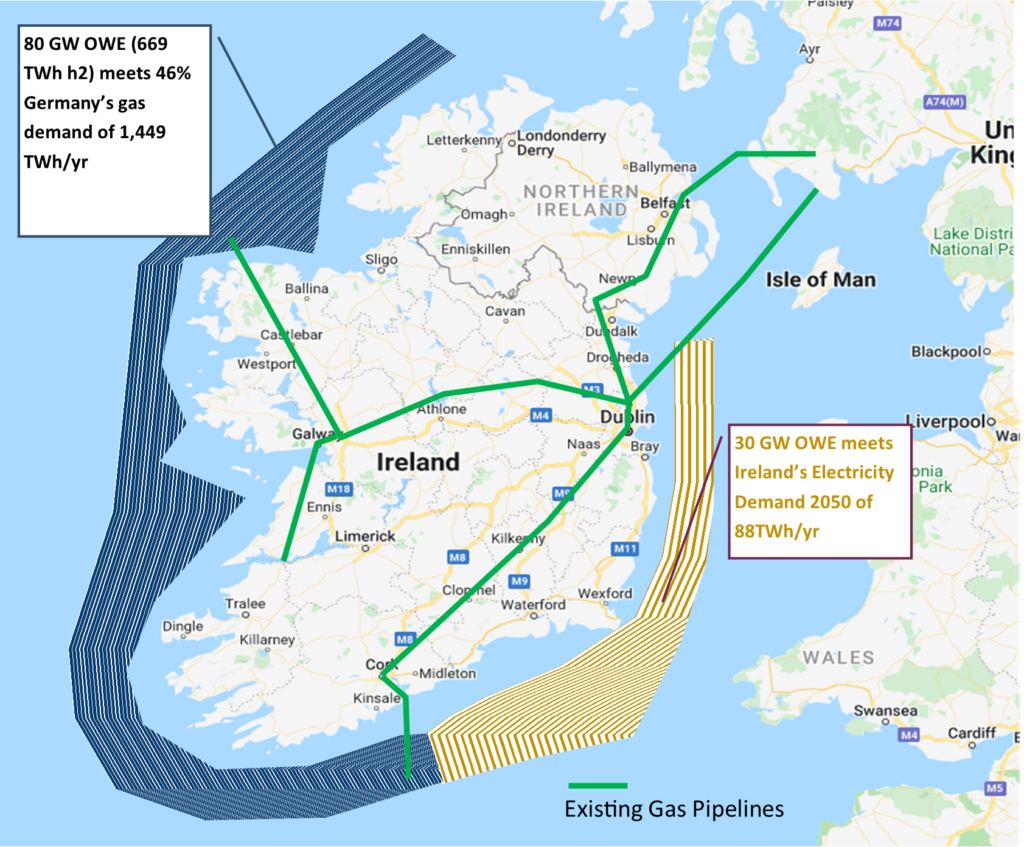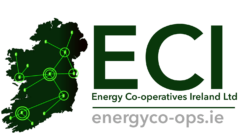
Renewable energy in Ireland is not just about electrcity and the grid.
Ireland has a vast potential for offshore wind energy (OWE), which can play a crucial role in Europe’s overall energy strategy and contribute to our climate goals. While the East Coast can meet domestic electricity demand, the West Coast has the potential to export significant amounts of OWE-generated hydrogen to Europe. To harness this opportunity, Ireland needs to focus on developing two pathways for decarbonization one on the East Coast usinbg OWE to electrcity for domestic consumption, and a West Coast export of OWE-generated hydrogen through an upgraded gas network. This will require investments in grid infrastructure, community engagement, and policy support.
As identified in The White Paper on Enterprise 2022-2030, offshore wind energy (OWE) at scale represents a key opportunity for industrial growth in Ireland which will not increase emissions. Ireland’s excellent wind resources, particularly on the West Coast should inspire Ireland’s policy enterprise to achieving the ambition to be the EU leader in this field.
To meet the target of 80% of our future electricity demand would likely require 33 TWh of OWE production, needing at least 7.3 GW of renewable energy – this is not including whatever solutions are required for excess generation to cope with intermittencies. It will be essential that a feasible technical solution to the issue of intermittency be built into the supply chain strategy, but we predict that this will not be in the form of battery storage alone, rather it will include hydrogen storage[1].
Electricity demand in Ireland is forecasted to significantly increase by 2050, ranging from 73 to 86 TWh[2].
Electricity is readily produced offshore, and the sector has been well established. There are 64GW of wind installed globally in 2023. The Global Wind Energy Council predicts an additional 380GW by 2033[3].
There are a large number of well-established players supplying technology into the OWE sector globally. EU based offshore turbine manufacturers include Nordex, Siemens, Vestas and Alstrom. Norway’s Equinor has recently opened the world’s largest floating OWE project at 88MW.
This would suggest that Ireland would be a host for existing international players meeting supply chain needs rather than developing its own OWE technology companies.
We expect that the 5 GW which will be OWE that are needed to help meet the 80% target of RE in Ireland by 2030 will be mainly located on the South and East Coast of Ireland where there is high energy demand. ORESS1 has approved 3GW to go to An Bord Pleanála and we expect that there is 700MW that will form part of ORESS2. The ‘Policy Statement on the Framework for Phase Two Offshore Wind’[4] from October 2023, also states that Phase 2 projects will be authorised according to expected grid capacity, but this will be in the region of 1.3MW to achieve the 2030 target of 80%.
The roll out of OWE on the West Coast needs to be an order of magnitude greater than the Island-centric opportunity mentioned above. Post 2030, we should expect an additional 10GW of installed OWE per decade.
Wind potential in Ireland far exceeds the expected level of demand that this country will have as discussed above. The issue that will face Ireland post-electrification of the domestic demand for fossil fuel replacement (kerosene for heating and electricity for small vehicle transport) will largely be one of most efficient means of energy export.
The potential for OWE in Ireland far exceeds the demand of this country in even the most optimistic scenarios of island-based technological developments. These opportunities have been recognised by both Norway and Scotland which have similar natural resources.
Germany faces the challenge of decarbonizing its economy while maintaining its competitiveness. To achieve this goal, hydrogen is emerging as a key energy carrier, offering a clean and versatile alternative to fossil fuels. Offshore wind, with its vast potential and consistent output, holds immense promise for powering hydrogen production and meeting Germany’s industrial energy demand[5].
The total volume of natural gas imported into Germany in 2022 was 1,449 TWh[6]. To decarbonize this will need to be replaced.
In 2045, hydrogen demand will be 265 TWh in total. Some 36% of this hydrogen will be produced in Germany. The remaining hydrogen will be imported.[7] This means that Germany will require 170TWh of hydrogen imports.
The potential OWE installation at current technological stages of development off the Western Coast is 80GW. This will produce approximately 315TWh of energy. Since the entire gas requirement in Ireland currently is 60TWh (and given that it will decline with increased building efficiency and heating electrification over time) this represents a significant net export opportunity.
We do not however envisage that the majority of this energy be exported via cable interconnector.
Ireland already has an infrastructure suited to conversion to energy export in the form of the existing gas grid. There is already considerable interest from high energy demand sectors in Europe (Netherlands and Germany) in any potential export of green energy from Ireland. The gas grid in the UK is already being readied for a 20% blending of hydrogen (H2) and natural gas (NG) in the UK grid. This will require Ireland’s grid to be prepared to accept the same blending ratio. It is our analysis that the gas grid in Ireland will be likely upgraded to accept blends of much higher ratios of H2:NG within this process. It is economically feasible to build out a parallel H2 only gas grid making use of the real estate currently held by Gas Networks Ireland which are favourable to the creation of such a H2 only network.
Ireland is the only EU country that can supply H2 directly into the gas grid from the resource rich North Atlantic. It is therefore vital that policy recognises the level of opportunity this energy demand in the Netherlands and Germany and puts in place educational, infrastructural, and policy foundations to enable us to meet this market demand.
There are naturally concerns about the potential environmental and social impacts of such an ambitious policy. Our work in the community energy sector has found that with the right balance of community participation, and financial and technical expertise from energy that align with sustainability ethos of the communities, overcome most of these concerns.
Our three projects lodged with MARA (Valentia, Árainn and Achill) are supported by their local communities as they themselves hold a significant stake at early stage of development. They recognise that they have a critical input into deciding who the technical and financial partners in the projects will be and they have excluded some, and embraced others. This major barrier of community acceptance into large scale sensitively planned OWE projects has therefore been overcome to this stage.
This cannot be said for the social and political context surrounding the upgrading of the electricity grid in the South West and Western regions that would be required to transmit electricity from OWE in Ireland to the EU.
It is our understanding from consultation with community and financial partners that Irish energy policy needs to be clear about how offshore wind energy needs to evolve with two platforms for decarbonisation:
- East Coast OWE (~7-8GW) meeting the on-island demand with some interconnection to facilitate balance of supply with UK and France.
- West Coast OWE (~80GW) meeting EU demand for hydrogen exported through an upgraded gas network with injection points at Galway, Mayo and Cork through Scotland.
Any policy that was overly focussed on the electricity grid being the only carrier of renewable energy would slow down the essential EU-wide sustainability targets of decarbonisation of the industrial heartlands of Europe. This would represent more than a missed opportunity for ‘Ireland Inc’: it would be socially and environmentally catastrophic on a EU wide level.
[1] Paolo Marocco, Domenico Ferrero, Andrea Lanzini, Massimo Santarelli, 2022, ‘The role of hydrogen in the optimal design of off-grid hybrid renewable energy systems’, Journal of Energy Storage, Volume 46,
, https://doi.org/10.1016/j.est.2021.103893
[2] https://www.eirgridgroup.com/site-files/library/EirGrid/Tomorrows-Energy-Scenarios-2023-Consultation-Report.pdf
[3] https://gwec.net/gwecs–global–offshore–wind–report–2023/
[4] https://www.gov.ie/en/publication/f3bb6-policy-statement-on-the-framework-for-phase-two-offshore-wind/
[5] https://www.reuters.com/business/energy/germanys-core-network-hydrogen-fuel-cost-20-bln-euros-by-2032-fnb-gas-chairman-2023-11-14/
[6] https://www.trade.gov/country-commercial-guides/germany-energy
[7] https://static.agora-energiewende.de/fileadmin/Projekte/2021/2021_04_KNDE45/A-EW_213_KNDE2045_Summary_EN_WEB.pdf
